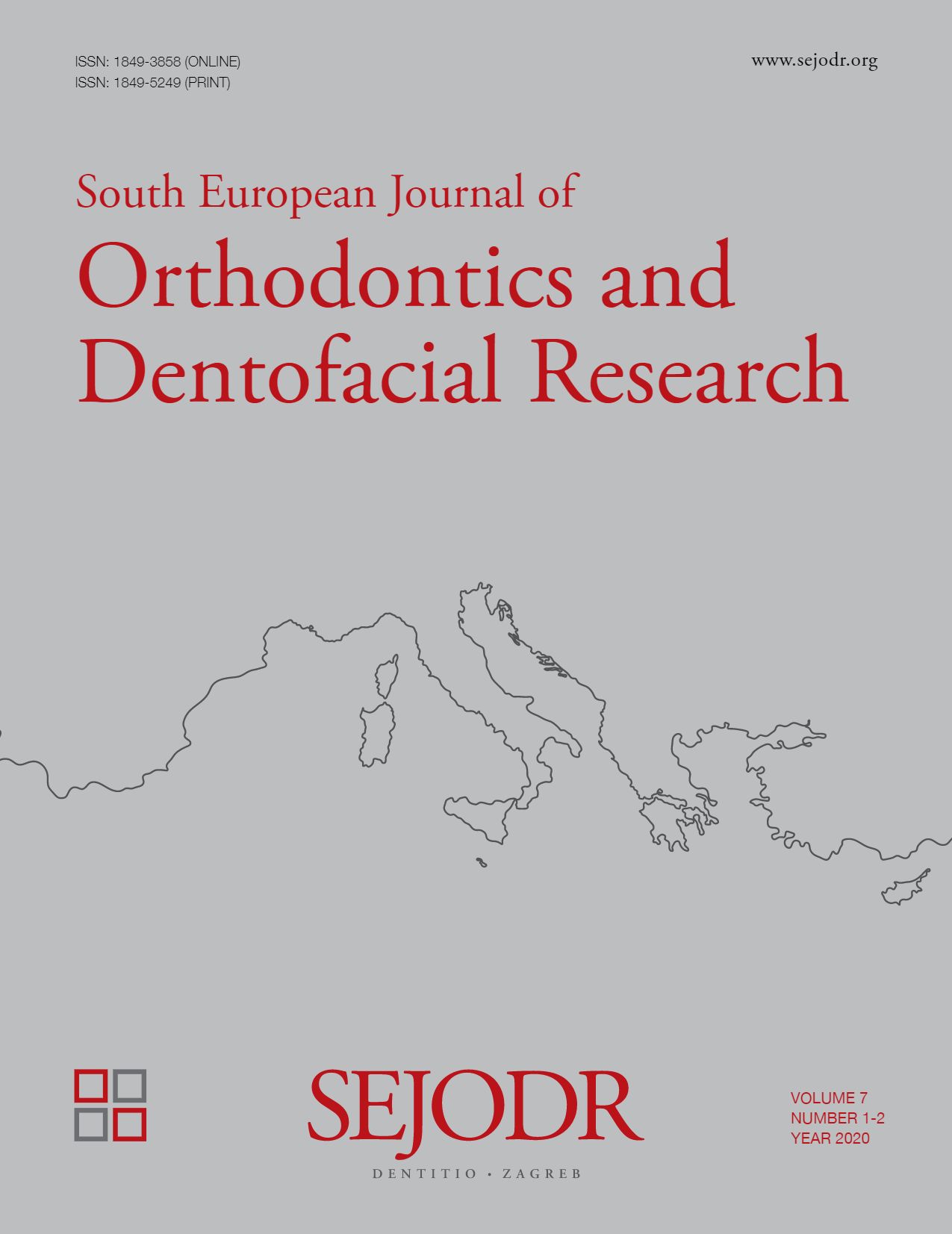Relationship between the position of maxilla and rapid maxillary expansion failure
Abstract
Introduction: The palatal expansion may be a challenging treatment in late adolescents who has passed the peak of skeletal growth. The success rate of palatal expansion in these patients decreases due to decreased growth potential.
Aim: It was aimed to determine any clinical/radiological indicator to be used as a predictor in the failure of rapid maxillary expansion (RME) in late adolescence.
Materials and methods: The records of the patients who had undergone RME therapy between the years 2013-2019 were evaluated. The patients were allocated into two groups according to expansion success: successful (S-RME) and failed (F-RME) RME groups. Fifty systemically healthy patients in the cervical vertebral maturation stage 5/6 were enrolled (35 females, 15 males). Eleven patients were (10 females, one male) in the F-RME group, and 39 patients were (25 females, 14 males) in the S-RME group. Five cephalometric (related to maxillary position) and three clinical variables (age, gender, and CVMS) were evaluated. Variables were subjected to multiple logistic regression analysis for setting a prediction model and detecting predictors.
Results: Patients with CVMS-6 had a 16.8-fold higher risk of palatal expansion failure than CVMS-5. 1 mm anterior position of PNS increased the risk of failure 2.9 times. 1 mm reduction in the distance between the PNS and cranial base in the vertical direction increased 60% the risk of RME failure.
Conclusion: The CVM stage of the patient, along with the vertical and sagittal position of the PNS, were found to be the possible predictors of RME success in late adolescence.
References
Melsen B. Palatal growth studied on human autopsy material. A histologic microradiographic study. Am J Orthod. 1975; 68: 42-54.
Cureton SL, Cuenin M. Surgically assisted rapid palatal expansion: orthodontic preparation for clinical success. Am J Orthod Dentofacial Orthop. 1999; 116: 46-59.
Garib DG, Henriques JF, Janson G, Freitas MR, Coelho RA. Rapid maxillary expansion--tooth tissue-borne versus tooth-borne expanders: a computed tomography evaluation of dentoskeletal effects. Angle Orthod. 2005; 75: 548-57.
Rungcharassaeng K, Caruso JM, Kan JY, Kim J, Taylor G. Factors affecting buccal bone changes of maxillary posterior teeth after rapid maxillary expansion. Am J Orthod Dentofacial Orthop. 2007; 132: 421-8.
Kilic N, Kiki A, Oktay H. A comparison of dentoalveolar inclination treated by two palatal expanders. Eur J Orthod. 2008; 30: 67-72.
Timms DJ, Vero D. The relationship of rapid maxillary expansion to surgery with special reference to midpalatal synostosis. Br J Oral Surg. 1981; 19: 180-96.
Mossaz CF, Byloff FK, Richter M. Unilateral and bilateral corticotomies for correction of maxillary transverse discrepancies. Eur J Orthod. 1992; 14: 110-6.
Mommaerts MY. Transpalatal distraction as a method of maxillary expansion. Br J Oral Maxillofac Surg. 1999; 37: 268-72.
Epker BN, Fish LC, Stella JP. Dentofacial deformities: integrated orthodontic and surgical correction. Mosby St. Louis; 1986.
Alpern MC, Yurosko JJ. Rapid palatal expansion in adults with and without surgery. Angle Orthod. 1987; 57: 245-63.
Capelozza Filho L, Cardoso Neto J, da Silva Filho OG, Ursi WJ. Non-surgically assisted rapid maxillary expansion in adults. Int J Adult Orthodon Orthognath Surg. 1996; 11: 57-66.
Handelman CS. Nonsurgical rapid maxillary alveolar expansion in adults: a clinical evaluation. Angle Orthod. 1997; 67: 291-305.
Revelo B, Fishman LS. Maturational evaluation of ossification of the midpalatal suture. Am J Orthod Dentofacial Orthop. 1994; 105: 288-92.
Wehrbein H, Yildizhan F. The mid-palatal suture in young adults. A radiological-histological investigation. Eur J Orthod. 2001; 23: 105-14.
Grunheid T, Larson CE, Larson BE. Midpalatal suture density ratio: A novel predictor of skeletal response to rapid maxillary expansion. Am J Orthod Dentofacial Orthop. 2017; 151: 267-76.
Angelieri F, Cevidanes LH, Franchi L, Goncalves JR, Benavides E, McNamara JA, Jr. Midpalatal suture maturation: classification method for individual assessment before rapid maxillary expansion. Am J Orthod Dentofacial Orthop. 2013; 144: 759-69.
Angelieri F, Franchi L, Cevidanes LH, McNamara JA, Jr. Diagnostic performance of skeletal maturity for the assessment of midpalatal suture maturation. Am J Orthod Dentofacial Orthop. 2015; 148: 1010-6.
Knaup B, Yildizhan F, Wehrbein H. Age-related changes in the midpalatal suture. A histomorphometric study. J Orofac Orthop. 2004; 65: 467-74.
Baccetti T, Franchi L, McNamara JA, Jr. An improved version of the cervical vertebral maturation (CVM) method for the assessment of mandibular growth. Angle Orthod. 2002; 72: 316-23.
Franchi L, Baccetti T, Tollaro I. Predictive variables for the outcome of early functional treatment of Class III malocclusion. Am J Orthod Dentofacial Orthop. 1997; 112: 80-6.
Persson M, Thilander B. Palatal suture closure in man from 15 to 35 years of age. Am J Orthod. 1977; 72: 42-52.
Isfeld D, Lagravere M, Leon-Salazar V, Flores-Mir C. Novel methodologies and technologies to assess mid-palatal suture maturation: a systematic review. Head Face Med. 2017; 13: 13.
Acar YB, Motro M, Erverdi AN. Hounsfield Units: a new indicator showing maxillary resistance in rapid maxillary expansion cases? Angle Orthod. 2015; 85: 109-16.
Schulze R. Radiation protection vs research interests. Dentomaxillofac Radiol. 2013; 42: 20120348.
Aps JK. To beam or not to beam: that is the question. Dentomaxillofac Radiol. 2013; 42: 20120375.
Isaacson RJ, Ingram AH. Forces produced by rapid maxillary expansion: II. Forces present during treatment. The Angle Orthod. 1964; 34: 261-70.
Bjork A. Sutural growth of the upper face studied by the implant method. Acta Odontol Scand. 1966; 24: 109-27.
Baccetti T, Franchi L, Cameron CG, McNamara JA, Jr. Treatment timing for rapid maxillary expansion. Angle Orthod. 2001; 71: 343-50.
The Creative Commons Attribution License cc-by-nc-nd formalizes these and other terms and conditions of publishing articles.
Copyright on any open access article in a SEJODR journal published by Dentitio d.o.o. is retained by the author(s).
Authors grant Dentitio d.o.o. a license to publish the article and identify itself as the original publisher.
Authors also grant any third party the right to use the article freely as long as its integrity is maintained and its original authors, citation details and publisher are identified.
The Creative Commons Attribution License cc-by-nc-nd formalizes these and other terms and conditions of publishing articles.

